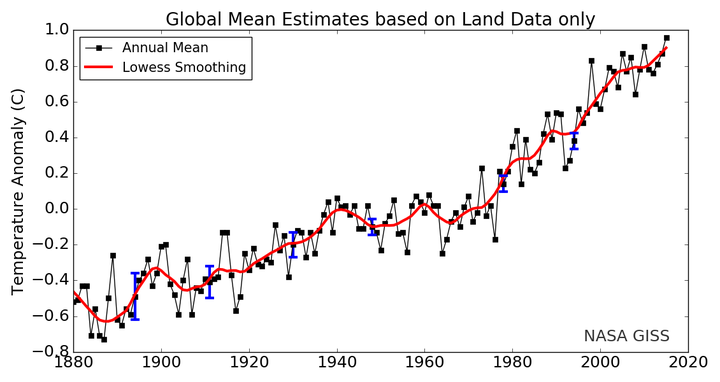Three weeks ago I offered a $25,000 challenge to Scott Armstrong, professor of marketing at the Wharton School (U. Pennsylvania), to bet me on whether global climate temperatures will set a new record in 2017 or not. Armstrong is best known to scientists for challenging former Vice President Al Gore to a “climate bet” in 2007. In preparation for a session called “Betting on Climate Change” at last month’s American Geophysical Union Fall Meeting, I helped compile a list of notable climate bets and challenges.
Armstrong has used his professional marketing skills to generate a lot of publicity for his challenge. He even created a website, “The Climate Bet,” which he updated a dozen times in 2016 with a “Gore V Armstrong” graph showing progress of the bet. He also produces a running commentary in which he refers to himself in the third person as “Professor Armstrong.” In the most recent edition (December 2016), he states, “After 14 months of global average temperatures closer to Mr. Gore’s warming scenario than to Professor Armstrong’s bet on no-trend, the Climate Bet is more in contention than it has been for the past four years.” In an earlier post he tells us that “it is mathematically possible for Gore to win,” but very unlikely.
Unless one reads Armstrong’s blog very carefully, it would be easy to assume that it had something to do with climate change or global warming. Neither is true, but the marketing ploy worked. Brit Hume of Fox News took the bait in 2007, writing “One expert Is willing to bet money Al Gore is wrong about global warming”.
Armstrong’s blog also implies that there is an actual, ongoing bet between Armstrong and Gore, but Gore did not accept the ambiguous challenge. Armstrong had not yet defined the settlement terms when he issued it. So it turns out that “The Climate Bet” is neither an actual bet, nor is it about climate. It did not belong on our list of notable climate bets in the summary poster we presented in our session, so we left it out. The language of marketing is about persuasion. The language of science is about precision.
Still, the idea of an ongoing bet on weather noise with progress reports intrigued me, and I searched Armstrong’s website looking for clues that would tell me how he was keeping score. I was unsuccessful in my quest and on Dec. 4 I wrote to Armstrong with a long list of questions, (e.g. “Did you ever issue this challenge with a rigorous and unambiguous settlement rule?”). Having received no answer, I challenged Armstrong to an actual bet on global warming, with well-defined and unambiguous settlement terms, on Dec. 10. I gave Armstrong the first right of refusal until the end of the year, after which time it would be available to any taker.
As of Jan. 1, 2017, the marketing professor has not taken my bet, nor has he answered my Dec. 4 questions. So here’s the challenge again, this time for the world:
Mark Boslough (MB) hereby presents a challenge as to whether the Earth’s climate will set a new record high temperature in 2017. The challenge will be settled using the NASA GISS mean global land surface temperatures for the conventional climate averaging period (defined by the World Meteorological Organization as 30 years) ending on December 31, 2017. If the global average temperature does not exceed the mean temperature for an equal period ending on the same date in any previous year for which complete data exist, MB will donate $25,000 to a nonprofit to be designated by the accepting party. Otherwise, the accepting party will donate $25,000 to a science education nonprofit designated by MB.

Meteorological station data only, 1880 to present, with base period 1951-1980. The solid black line is the global annual mean and the solid red line is the five-year lowess smooth. The blue uncertainty bars (95% confidence limit) account only for incomplete spatial sampling. From NASA GISS.
